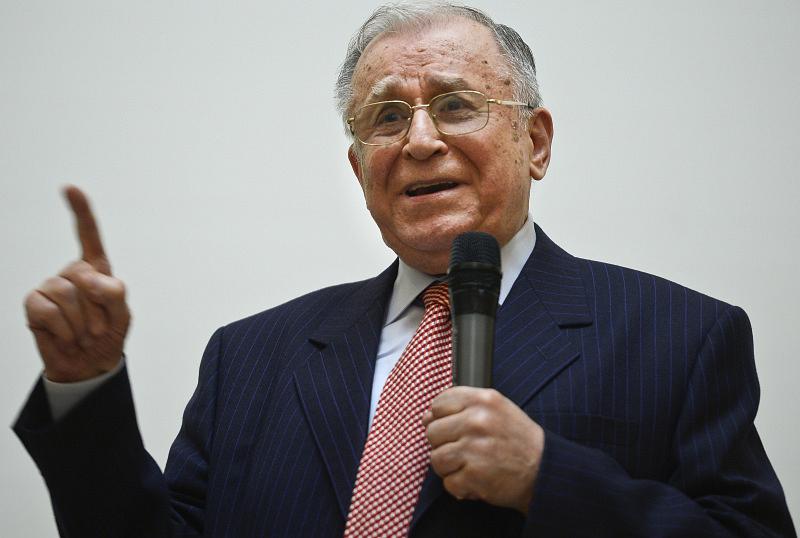Former Romanian President Ion Iliescu: Not everything that we lived under communism was bad



As Romania marks 27 years since the December 1989 Revolution, former President Ion Iliescu, who rose to power after those events, thinks that “not everything that we lived under communism was bad, and not all that we now live is better.” Iliescu, 86, wrote a blog post about the Romanian Revolution and how it has changed the country. He described the revolution as a “moment of dignity and courage, solidarity”.
“The fall of Ceausescu’s regime, a personal dictatorship that made it impossible to have a peaceful transition at political and economic level, is the symbol of the fall of communism in Eastern Europe,” Iliescu wrote.
He thinks that Romanians should be proud of those events, which “started as a popular riot and turned into a veritable revolution”, and that time will show “what a great thing we did in those days and how much we have accomplished since then”.
“Nobody had a magic wand so that in a few seconds we passed from one dimension to the other, from planned, centralized economy to a market economy, from a totalitarian regime with one single party to a democracy with multiple parties,” Iliescu wrote, adding that this change has been achieved with multiple sacrifices.
“Not everything we lived under communism was bad, not everything we live now is good. But now we have something we didn’t have then: the freedom to change what is bad. It’s up to us how we use that freedom,” the former President said.
He mentioned some of Romania’s achievements in the past 27 years, such as joining the European Union and NATO, modernizing its public institutions, and developing its economy. However, he also thinks that “there is too much poverty, and we have problems in education, healthcare, and welfare.”
He closed his post saying that “we must bow to all those who fought totalitarian regimes in the 20th century.” “Each one, in his own way, loved his country and made the supreme sacrifice for her sake.”
However, leaving aside the significance of the Romanian revolution, the mystery of the people killed during those days hasn’t been solve yet. More than 1,100 people were killed and over 3,300 were injured during the December 1989 events in Bucharest, Timisoara, and other Romanian cities. Most people lost their lives or were injured in the armed confrontations that followed after dictator Nicolae Ceausescu fled Bucharest, on December 22, 1989, at noon.
People were called to defend the Revolution against so-called terrorists hired by the old regime. In the end, soldiers, police and special forces, civilians ended up shooting each other, driven by orders received from various people.
The Romanian Revolution case was closed last year, but Romania’s General Prosecutor Augustin Lazar reopened the investigation in June this year. In November, the military prosecutors in charge of the Revolution case decided to expand the investigation adding charges of crimes against humanity to the case. Prosecutors said that they are looking at the “new political and military” leadership that was installed after December 22, 1989.
In order to keep the power, the new leadership installed after December 22, 1989, determined the “killing, wounding by gunshot, damaging physical and psychological integrity, and deprivation of liberty of a large number of people”, according to the military prosecutors.
Prosecutors also said that in December 1989 there was “a generalized attack”, and the proof was the “high number of places where armed incidents took place”. This also shows to the existence of a plan according to which things happened, “a plan that aimed to create a state of confusion among the among the armed forces, by dividing the leadership of the Ministry of National Defense and disseminating orders, reports, and false information, bringing the population in the streets and arming people, respectively creating the appearance of a ‘civil war’ in which military units belonging to the National Defense Ministry and the Interior Ministry or even within the same ministry fought, with the aim to take over the power and legitimize the new leaders,” according to the military prosecutors.
Romania’s General Prosecutor said the investigation should be finalized in early 2017. For now, prosecutors are investigating the facts and haven’t prosecuted anyone in this case.
In October 2015, Ion Iliescu and other former state officials were charged with crimes against humanity in the 1990 miners’ riot case. The case is related to the violent repression of the protesters against Ion Iliescu’s new regime, in mid-June 1990, only six months after the 1989 Romanian Revolution.
Asked to comment on the prosecutors’ decision to reopen the Revolution and Miners’ Riot cases, Ion Iliescu said in February this year that “we’ve moved over them (the deeds of the revolution), we’ve passed (the moment). What’s the point of digging up all this?”
Ion Iliescu, a former official of the Romanian Communist Party (PCR), was a central character of the Romanian Revolution in December 1989. He led the Council of the National Salvation Front (FSN), which was set up as a temporary organism to ensure the transition from the old regime to the new, democratic one. Although FSN was supposed to function only for a short period, in February 1990, it was registered as a political party, and in May 1990 it won the first parliamentary elections. Iliescu himself was elected Romania’s President.
In 1992, FSN broke into two political parties: one that became the current Social Democratic Party (PSD), and the Democratic Party (PD), which merged with the National Liberal Party (PNL) in 2015.
Ion Iliescu was President of Romania from May 1990 until November 1996, and then again from December 2000 until December 2004.
editor@romania-insider.com